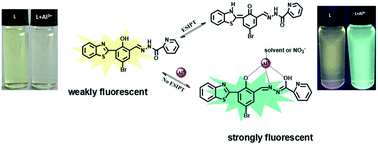A new ‘turn-on’ and reversible fluorescent sensor for Al3+ detection and live cell imaging†
Abstract
Herein, we report a new benzothiazole-based azomethine receptor L as a reversible fluorescent sensor for the selective detection of Al3+ in buffered aqueous methanol (20 mM HEPES, pH = 6.0, 50% (v/v) CH3OH). The fluorescence enhancement response of L towards Al3+ along with a large blue shift (Δλ = ∼157 nm) may be attributed to the formation of the L–Al3+ complex, which results in the inhibition of excited state intramolecular proton transfer (ESIPT) and C![[double bond, length as m-dash]](https://www.rsc.org/images/entities/char_e001.gif) N isomerisation as well as the chelation enhanced fluorescence (CHEF). The results of Job's plot and mass spectroscopic analysis support the 1 : :1 stoichiometry of the complex between L and Al3+ ions. The proposed complex structure was calculated by applying the DFT method. Furthermore, the applicability of the probe has been tested in BEL-7402 human hepatoma carcinoma cells under a fluorescence microscope, where turn-on, intense bluish green fluorescence was observed in the presence of Al3+ ions.
N isomerisation as well as the chelation enhanced fluorescence (CHEF). The results of Job's plot and mass spectroscopic analysis support the 1 : :1 stoichiometry of the complex between L and Al3+ ions. The proposed complex structure was calculated by applying the DFT method. Furthermore, the applicability of the probe has been tested in BEL-7402 human hepatoma carcinoma cells under a fluorescence microscope, where turn-on, intense bluish green fluorescence was observed in the presence of Al3+ ions.



 Please wait while we load your content...
Please wait while we load your content...